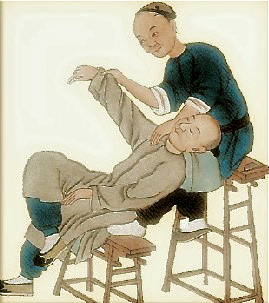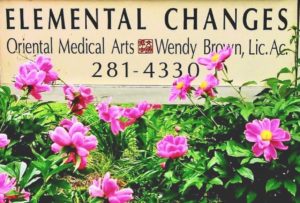ACUPUNCTURE
The body is traversed by a network of energy conduits referred to as meridians, vessels, or channels. Acupuncture needling connects with Qi through specific sites along the channel where Qi can be measured to pool. By stimulating and directing the flow of Qi, the body’s innate healing force is directed to internal organs, external sense organs, muscles, tissues, tendons, bone, and the fluids of the body. Fine gauge, pre-sterilized acupuncture needles are inserted beneath the skin which remove obstruction in the meridians and muscle layer. Needle manipulation techniques are meant to promote sensation, not pain, as the needle contacts Qi. The sensations can be experienced as dull or tingling, local, or traveling, and are regarded as a sign of effective needling.
ACUPUNCTURE NEEDLES
Used for acupuncture, or Zhēnjiǔ 针灸, needles are almost exclusively constructed of stainless steel – although gold, zinc, and copper are used in specialized treatment for the charge their alloy imparts. The high-quality needles we use are those which have been sharpened and polished by precision machinery with an emphasis on high tensile strength. They are silicon coated to create an extremely smooth surface of the blade and completed with an ethylene oxide gas sterilization (which can keep individually packaged needles sterile for approximately 5 years). Gauge (thickness) and length vary considerably depending upon factors, from patient comfort to desired effects/results of treatment, to anatomical terrain, etc. Disposable acupuncture needles are intended for single use and disposed of in biohazardous waste containers, then handled accordingly.
Qi
Qi is not unique to humans. We are surrounded by it and live in a field of Qi, and yet we are usually unaware of it. Through Chinese medicine and its ancient branches of healing, we learn how to sense this life energy in ourselves and in the environment. Building and circulating Qi in our bodies improves health and cultivates a tranquil, aware state of mind.
Ling Shu Chapter 1: The crucial point of acupuncture technique is to reach the “Qi-arrival”; the curative effect of acupuncture depends upon it. This notable curative effect may be described as if the wind blows away the clouds and the bright blue, cloudless sky appears again.
Ling Shu Chapter 3: “Qi-arrival” refers to Yin and Yang meeting in balance. The Língshū 灵枢经 also known as The Celestial Pivot, compiled in the 1st century BCE, is an ancient Chinese medical text.
CHINESE HERBAL MEDICINE
Although there are several thousand more herbs used in China, we in the West commonly utilize about 500 herbs and medicinal substances in our pharmacies. These substances are discussed in Bensky’s 3rd edition of the Materia Medica, the definitive modern collected body of knowledge of Chinese herbs 草药, in the West. Herbs are considered plant matter, minerals, and some animal-derived medicinals which have been ethically cultivated and gathered.

Raw Chinese Herbs ©Image/W.Brown
+ The medicinal actions are described in terms of temperature characteristics: hot, warm, neutral, cool, cold; varying degrees of hot and cold.
+ The properties of tastes of Chinese herbs: acrid, sweet, bitter, sour, salty, bland.
+ The channels into which each substance enters
In Oriental herbal medicine, art is in the combining of herbs for their synergy within the formula and resonance in healing a patient’s disharmony. Historical formulas are manufactured by herb companies today for their timeless applications. Current research and empirical trials also highlight modern clinical applications for Chinese herbs. Most bulk tea prescriptions include an average composition of six to twelve medicinal substances combined.
Herbs may be taken internally in the form of teas, granular powders, tablets, tea pills, tinctures, and syrups; prepared versions for external application are liniments, plasters, and washes.
- When prescribed by a qualified practitioner, Chinese herbs create none of the side effects of synthetic drugs. Even though it may take longer to notice the effects of herbs than it might pharmacological medicine, the benefits are strengthening and the benefits are long-lasting because the body is being balanced and nourished rather than the extension of symptoms mere concealment.
- Chinese herbal formulas are comprised largely of plant materials however, some medicinals may also contain animal components such as bones, shells, and various animal sloughs. If you are Vegan or Vegetarian interested in products without animal aspects, specify this and I will do my utmost to support and accommodate this intention.
MOXIBUSTION

Needle Moxibustion ©Image/W.Brown
Moxibustion is a warming technique that is most often used in conjunction with acupuncture needling. It is a primary facet of treatment in oriental medicine. Moxa, the herbal agent used, is known by the western botanical name of Artemesia Vulgaris, or Ai Ye in Chinese herbal medicine. It can be found in various forms in treatment; whether rolled into cigar-like sticks and hand-held above certain acupoints while it smolders, or is fashioned into slices and burned on the heads of the acupuncture needles themselves. Much less commonly here in the USA, moxa may be fashioned into tiny cones and applied by setting it on the skin and burning the cone on top of the skin directly. The function of moxa in any of its forms is to transfer therapeutic heat into the meridians, thereby expelling cold and promoting the smooth flow of Qi and blood. Moxibustion techniques are prized even in ancient traditional medicine for promoting longevity and treating many conditions of a cold, damp, or painful nature.
PULSE DIAGNOSIS
Pulse reading and visual tongue examination in oriental medicine are medical arts & diagnostic tools which offer unique insights to distinguish a patient’s pattern of disharmony.
Pulse reading is a sophisticated means of understanding the whole person. Pulse examination occurs at the radial arteries of both wrists, in three distinct positions. There are many models of pulse diagnosis practiced within oriental medicine. As a diagnostic medium, the pulse reveals a patient’s constitution, previous illnesses, early physiological insults, environmental stressors, trauma, lifestyle, emotions, and behavior. It also predicts future pathologies with accuracy. Many factors influence the pulse and tongue and so it is important to evaluate both at each visit before an acupuncture treatment to check the current states of the internal organs, Qi, and humors of the body. As is all of Chinese medicine, pulse reading is an art, tongue diagnosis a skill, both of which are honed over a lifetime of practice, perception, and understanding.
TONGUE DIAGNOSIS

Insights offered by the tongue
A healthy tongue body is pinkish or light red in color and indicates the state of nutritive Qi, Blood, and organ strength. Internal constitution can affect the shape of the tongue body, although the shape and texture of the tongue body basically reflect varying states of excess or deficiency. Moisture present on the tongue reveals the condition of yin and bodily fluids. A tongue coating indicates the state of the yang organs; If the coating is thick it may indicate the retention of food, or that an exterior pathogenic factor has penetrated more deeply into the body. Yin is damaged when the tongue presentation not only lacks coating but has a peeled or shiny, rootless effect. In this case, the color of the tongue body itself will lend more information as to whether the factor presented is due to heat, severe heat, or deficiency. Cracks over the tongue body, color of tongue coating [i.e. yellow, white, grey, black, and simultaneous combinations, whether the tongue quivers, has teeth marks along the sides or is tender, is deviated or numb, has ulcers or black spots, red prickles, white or peeled patches and presented at what areas of the tongue’s topography, present a practitioner with a depth of insight that contributes to accurate diagnosis and treatment by acupuncture and herbs.
MANUAL TECHNIQUES
Oriental medicine is composed of ancient Asian healing arts that for centuries have promoted vitality and corrected health problems

Cupping by fire method
CUPPING
Cupping, Báguàn 拔罐, is a traditional technique that uses specialized glass or bamboo cups on particular surface areas of the body. A vacuum seal is created often by using a small flame as a heat source to suctioning out the air. The suction that is created releases the flow of Qi in the muscle layers and helps to alleviate wind headache, colds, and flu with body aching, ‘Bi’, or painful syndromes, as well as useful for detoxification and asthma. Stagnation is drawn from deeper layers of tissue up to the surface. Reddish or purple circular markings may remain at the local area for several days following a cupping treatment. This is a completely natural result due to blood stasis.

Gua sha tools of ceramic & horn
GUA SHA
A ceramic spoon or a polished, smooth-edged animal horn is used as a massage tool over well-oiled skin in Guāshā 刮痧. ‘Sha’ or a ‘sand-like eruption’ from deep muscular tissues rises to the surface. This method allows the expression of blood that has hardened or stagnated, as well as lymph and stagnant QI that has been stored in the muscles to be circulated and resolved. Painless purple, varying to black subcutaneous sha will be visible for several days following this treatment method.
TUI NA MASSAGE
TUI NA 推拏 Translated as ‘Pushing-Grasping,’ is Chinese medical massage, comprised of very effective manipulation techniques that treat a variety of structural and orthopedic conditions, sports injuries as well as connective tissue disorders.
Techniques of striking, swinging, pinching, pressing, vibrating, rolling, pushing, and tapping between joints [known as the Eight Gates] open defensive Wei Qi and accentuate Qi and Blood in the meridians, musculature, and ultimately align the musculoskeletal form. Combined with Acupuncture, Tuīná treats both acute and chronic musculoskeletal conditions, as well as many non-musculoskeletal conditions.
Experience all of these in-depth treatments that will leave your being in a harmonious state of peace




